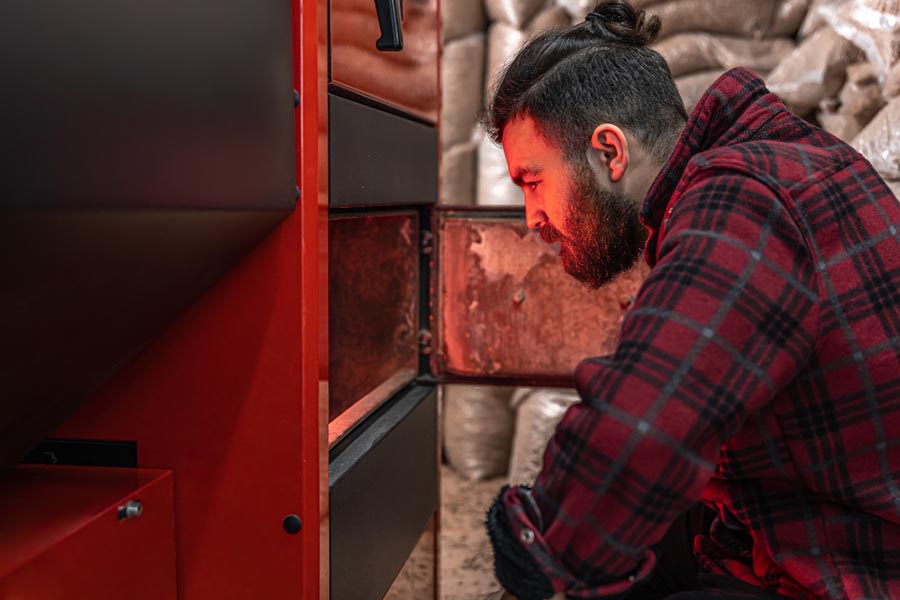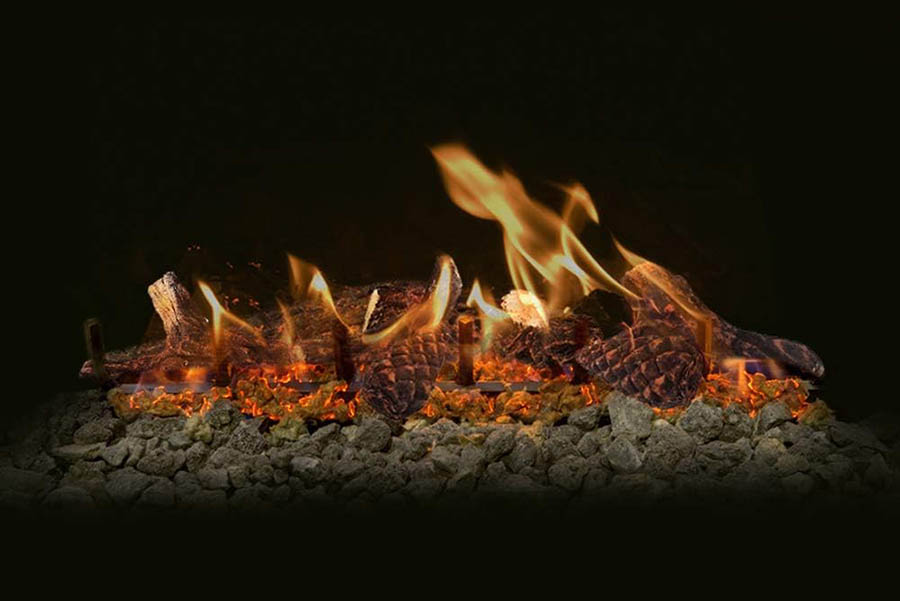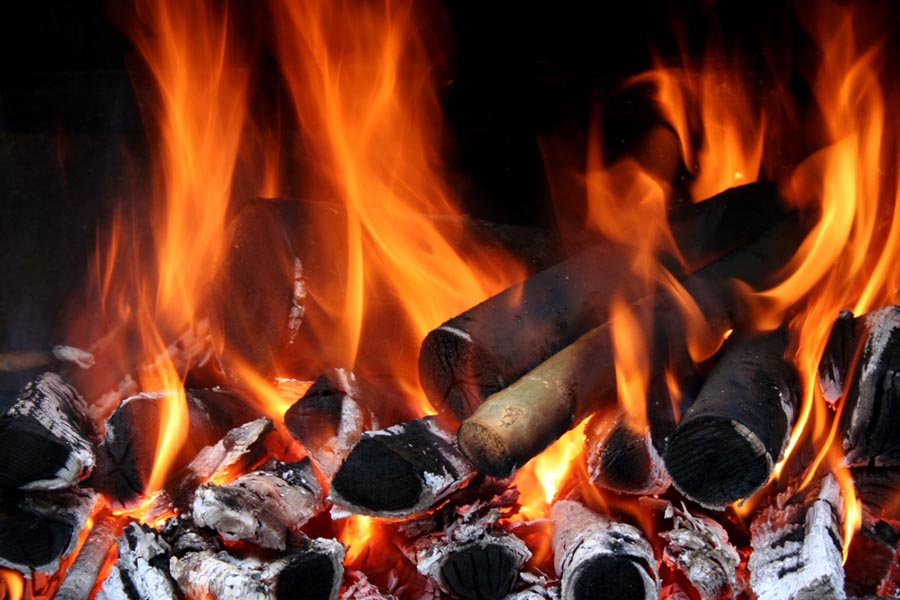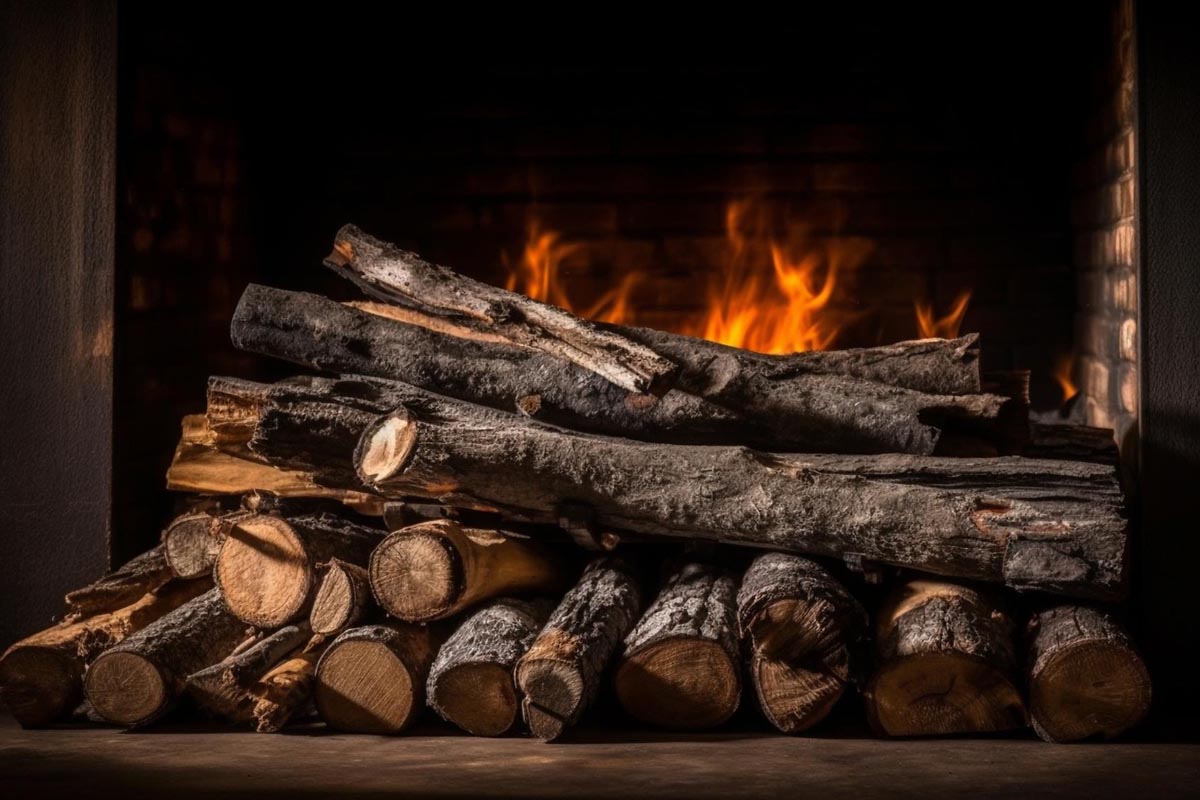Gas fireplaces have gained significant popularity among homeowners seeking the comforting warmth and ambiance of a traditional fireplace without the inconveniences associated with wood-burning counterparts.
Gas fireplace logs, also known simply as gas logs, are a key component of these modern hearths. They offer convenience, cleanliness, and the cozy charm of a real fire.
If you’re considering installing a gas log fireplace or you already have one, you might be wondering about the lifespan of gas logs and how long you can expect them to last.
Types of Gas Fireplaces

Before we dive into the longevity of gas fireplace logs, let’s briefly explore the different types of gas fireplaces available in the market.
Understanding these variations in gas log sets can provide valuable insights into the lifespan of the logs used in them.
Ventless vs. Vented Gas Fireplaces
Gas fireplaces come in two primary types: ventless and vented. Ventless gas fireplaces, as the name suggests, do not require a chimney or external venting.
Vented fireplaces, or gas fireplace inserts on the other hand, need proper ventilation to make gas valves expel combustion byproducts. The type of fireplace you have can impact the lifespan of your gas logs.
Differences in Gas Logs for Various Types
The logs used in ventless and vented gas fireplaces can differ in composition and design.
Ventless gas logs must burn more cleanly because they release combustion byproducts into the living space, requiring special ceramic or refractory materials.
Vented gas logs have more flexibility in design since they expel byproducts outside the gas line, but they still need to be durable.
The Lifespan of Gas Fireplace Logs
Now, let’s get to the heart of the matter: how long do gas fireplace logs typically last, and what factors influence their longevity?
Average Lifespan of Gas Logs
The average lifespan of gas logs can vary widely depending on several factors, including the quality of the logs, the frequency of use, and how well they’re maintained.
Generally, you can expect gas logs to last anywhere from 5 to 10 years or more.
Factors Affecting Longevity
Several factors play a crucial role in determining the lifespan of your modern gas logs:
- Quality of Materials: Gas logs can be made from ceramic or refractory materials. Refractory logs tend to be more durable and have a longer lifespan.
- Frequency of Use: If you use your gas log fireplace frequently, the logs may wear out faster than those in fireplaces used infrequently.
- Maintenance: Regular maintenance and cleaning can extend the life of your gas logs. Neglecting maintenance can lead to premature failure.
In the next section, we’ll delve deeper into the signs that indicate it’s time to replace your gas logs and how to extend their lifespan.
Signs It’s Time to Replace Gas Logs
As gas logs age, they may exhibit wear and tear. It’s essential to know the signs that indicate it’s time for replacement to maintain the safety and efficiency of your gas fireplace.
Identifying Wear and Tear
Common signs of wear and tear in gas logs include:
- Cracks: Cracked gas logs are a clear sign of deterioration and should be replaced promptly.
- Burning Irregularities: If the flames no longer evenly distribute across the logs or if they produce excessive soot or carbon buildup, it’s time for inspection.
Safety Concerns
Continuing to use gas log sets that are worn out or damaged can pose safety hazards. Gas leaks or incomplete combustion can result in carbon monoxide emissions, which are a serious health risk. Ensuring the integrity of your gas logs is essential for safe operation.
Extending the Lifespan

Extending the lifespan of your gas log is not only cost-effective but also ensures you can enjoy your cozy fires for longer periods. Here are some essential maintenance tips and care practices to consider:
Maintenance Tips
Routine maintenance is key to preserving the life of your vented gas logs. Consider these tips:
- Regular Cleaning: Clean the logs periodically to remove dust, soot, and debris. Use a soft brush or cloth to prevent scratches on the surface.
- Inspect for Damage: Keep an eye out for any visible cracks, chips, or signs of wear during cleaning sessions.
- Vent Inspection: If you have a vented gas fireplace, check the venting system for any obstructions or damage.
Cleaning and Care
Proper cleaning and care can significantly impact the lifespan of your gas logs. Here’s a simple cleaning routine to follow:
- Turn off the gas supply and allow the logs to cool completely before cleaning.
- Remove the logs carefully, taking note of their arrangement. You’ll need to place them back in the same order.
- Clean the logs with a soft brush or cloth to remove soot and dust. Be gentle to avoid damaging the surface.
- Inspect for any signs of damage while cleaning. If you notice cracks or other issues, it’s time to consider replacement.
- Reassemble the logs in their original positions.
Gas Log Materials

The material from which your gas logs are made can significantly influence their lifespan. Let’s explore the three primary types: ceramic, refractory, and cement logs.
Ceramic fiber logs are lightweight and designed to mimic the look of real wood. While they are less expensive, they tend to have a shorter lifespan compared to refractory or cement logs.
Refractory logs are constructed from a dense, heat-resistant material. They are more durable and can withstand high temperatures, making them an excellent choice for long-term use.
The cement logs are another option, known for their durability and extreme heat resistance. They are often chosen for their long lifespan and ability to withstand the rigors of frequent use.
Ceramic vs. Refractory Logs
Ceramic logs are lightweight and designed to mimic the look of real wood. While they are less expensive, they tend to have a shorter lifespan compared to refractory logs.
Refractory logs are constructed from a dense, heat-resistant material. They are more durable and can withstand high temperatures, making them an excellent choice for long-term use.
In the next section, we’ll discuss all the benefits and cost considerations associated with gas fireplace logs and explore ways to make cost-effective choices.
Cost Considerations
When considering the lifespan of entire fireplace setup and logs, it’s important to factor in the costs associated with their maintenance and replacement.
Replacement Costs
The cost of replacing gas logs can vary depending on factors such as the type of logs, their size, and brand. Generally, refractory logs tend to be more expensive upfront but offer better durability, potentially reducing replacement costs over time.
On the other hand, ceramic logs are typically more affordable but may need more frequent replacements.
Cost-Effective Choices
To make cost-effective choices when it comes to gas logs, consider the following:
- Quality Over Price: Investing in high-quality, durable gas logs, such as refractory logs, might seem more expensive initially but can save you money in the long run by lasting longer.
- Regular Maintenance: Proper and regular maintenance can help extend the lifespan of your gas logs, reducing the need for frequent replacements.
- Compare Brands: Research different brands and read customer reviews to identify those known for producing long-lasting gas logs.
DIY Replacement vs. Professional Service
When the time comes to replace your gas fireplace logs, you’ll have the option to either do it yourself or hire a professional. Let’s explore the pros and cons of each choice:
DIY Replacement
- Pros: Cost-effective, can be done on your schedule, no labor costs.
- Cons: Requires technical knowledge, potential for mistakes or safety hazards.
Professional Service
- Pros: Expertise and experience, ensures safety, may identify other issues, such as gas leaks.
- Cons: Higher cost due to labor and service fees.
Choosing between DIY replacement and professional service depends on your comfort level with the task and your willingness to invest in professional expertise.
Gas Fireplace Logs vs. Traditional Wood

Gas fireplace logs offer modern convenience, but how do they compare to traditional wood-burning fireplaces in terms of longevity and convenience?
Longevity and Convenience Compared
Gas fireplace logs have a distinct advantage in terms of convenience. They are easy to ignite, require no hauling of firewood, and produce consistent flames and heat with just the flick of a switch or remote control.
In contrast, traditional wood-burning fireplaces require more effort and maintenance.
- Longevity: Gas logs tend to last longer than traditional wood fires. With proper care and maintenance, gas logs can provide a consistent flame for many years, while wood-burning fires often demand more frequent wood replenishment.
- Convenience: Gas fireplaces offer the convenience of instant warmth and the ability to control flame height and heat output. They eliminate the need for gathering, chopping, and storing firewood.
Environmental Considerations
When comparing gas fireplace logs to traditional wood-burning, there are environmental considerations to take into account:
- Emissions: Gas fireplaces produce fewer emissions compared to burning wood, which can release particulate matter and contribute to air pollution.
- Sustainability: Wood-burning fireplaces rely on a finite resource—wood. Gas fireplaces, on the other hand, use a readily available and often cleaner-burning natural gas or propane.
Next, let’s explore the process of replacing gas fireplace logs and when it’s best to seek professional assistance.
How to Replace Gas Fireplace Logs
Replacing gas fireplace logs may seem like a daunting task, but with the right guidance, you can do it yourself. Here’s a step-by-step guide:
- Safety First: Turn off the gas supply to your fireplace and ensure the area is well-ventilated.
- Remove Old Logs: Carefully remove the old gas logs, taking note of their arrangement.
- Clean the Fireplace: Clean any dust or debris from the fireplace to ensure proper ventilation.
- Inspect Gas Lines: Examine the gas lines for leaks or damage.
- Install New Logs: Follow the manufacturer’s instructions to place the new gas logs in the correct configuration.
- Check for Leaks: Turn on the gas supply and check for any gas leaks around the connections.
- Test the Flame: Light the fireplace and observe the flames to ensure they burn evenly.
When to Seek Professional Help
While replacing gas logs can be a DIY project for some, there are situations where it’s best to enlist the help of a professional:
- If you are uncomfortable working with gas lines or lack the necessary technical knowledge.
- When you suspect gas leaks or other safety concerns.
- If your gas logs are part of a complex venting system or unique setup.
Conclusion
In conclusion, the longevity of gas fireplace logs depends on various factors, including their quality, maintenance, and usage patterns. Understanding how just the logs show signs of wear and when you need to replace them is crucial for safety and efficiency.
Gas logs offer a convenient alternative to traditional wood-burning fireplaces, with longer-lasting flames and fewer environmental impacts. The choice between gas and traditional wood logs ultimately depends on your priorities and lifestyle.
Whether you choose gas logs or wood, proper maintenance is key to maximizing their lifespan. Regular cleaning, inspections, and care can help you enjoy the warmth and comfort of your fireplace for years to come.
If you have any more questions or need further guidance, don’t hesitate to consult with a professional fireplace technician for assistance.
Thank you for exploring the lifespan of gas fireplace logs with us, and we hope this information helps you make informed decisions for your home.






